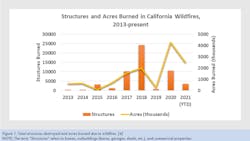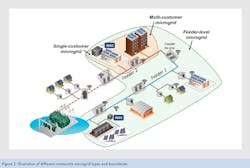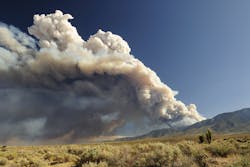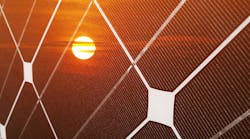Since 2013, California has had more than 12 million acres (4.9 million hectares) scorched by catastrophic wildfires, resulting in more than 200 deaths and the loss of 54,000 structures. Under the right conditions, any spark could result in a disastrous event. As a result, utilities have invested billions of dollars in asset hardening and wildfire risk mitigation.
These efforts include fuel vegetation management, asset replacement and the introduction of practices such as public safety power shutoff (PSPS). PSPS is designed to help minimize fire risks in critical weather by proactively deenergizing certain high-risk pathways. This targeted approach has shown to be beneficial in preventing fuel ignition, but it also can introduce negative impacts on communities and vulnerable customers. For example, during PSPS events, emergency services may be in high demand and yet difficult to access. This includes essential resources such as water systems, police and fire department services, wireless telecommunication and transportation infrastructure.
Local solutions may be the answer to balance the benefits of PSPS with societal needs for electricity resilience. For solutions to be successful, they must be affordable, safe and, preferably, aligned with emission reduction goals. That means new renewable, emission-free battery storage and distributed energy resources (DER) may hold increasing promise over traditional gasoline, diesel and natural gas generators.
Promise Of DERs
DERs can be purchased and operated by individuals, businesses, government agencies, electric utilities or third-party businesses. However, they all typically connect to the region’s shared power system. Because of this interconnection, a single customer’s actions can impact others within the system. In the instance of PSPS events, a customer-owned solar-plus-battery system may operate as backup power. During normal grid-connected periods, this same system could be used to prevent brownouts by supporting peak load times for the entire grid on high demand days. For a DER to operate without the grid, it must have some form of isolation from the grid. This isolation along with some control technology — critical for worker safety — make the DER a microgrid.
To better understand the potential opportunities for DER and microgrid solutions to support PSPS events caused by wildfires, the Electric Power Research Institute (EPRI) recently published a white paper, Wildfires and Public Safety Power Shutoffs: Distributed Energy Resources for Community Electricity Resilience.
In this study, DERs and microgrids were investigated for their potential to provide energy resilience during PSPS events. Because electrical infrastructure is only one of many possible sources of ignition, destructive wildfires can still happen during PSPS. Customers, communities and utilities need a portfolio of strategies to mitigate the effects of wildfires and power outages, particularly during conditions when wildfires and outages happen simultaneously.
Safe Storage And Interconnection
Expanding DER adoption is dependent on the successful delivery of safe, reliable and secure solutions. Over the years, battery storage has made considerable advances with improvements in technology, monitoring tools and processes. DERs used in a microgrid can be considered as part of a fire-hazard mitigation analysis. Continued research and funding to identify, assess and address battery storage fire safety, like those outlined in EPRI’s battery storage fire safety roadmap, help to guide best practices for safe battery storage deployment.
Proper interconnection of DERs is required to enable both the customer and utility benefits. Safe and efficient interconnection requires coordination among customers, local permitting authorities and electric utilities. EPRI’s Interconnection Taxonomy working group brings together these stakeholders together with product manufacturers and third-party integrators to collaborate on use case, control mode and application terminology. Bringing these stakeholders together can help to align goals and objectives of DER abilities to support wildfires and PSPS events. It also can help to ensure grid compatibility and protection from issues such as back feed by holding DER equipment to recognized industry standards, like IEEE 1547.
System Planning
Utilities are challenged to incorporate DERs into power system planning to maximize benefits during normal (blue-sky) days and emergency (black-sky) days. Managing unintended impacts to power quality and reliability requires consideration of the following:
- Customer adoption forecasting — Customer behavior can shape the economic and grid benefits from residential battery storage. To plan for and potentially incentivize this behavior, utilities should
objectively analyze customer economics and preferences. - Utility tariff and program design — Incorporating novel utility program and tariff designs may help to improve alignment in DER deployment and operation for broader
societal benefits. This will require continuing research into optimization and simulation tools to investigate DER life-cycle costs and benefits from both the customer and utility perspectives. - Equity and access considerations — Some customers and communities may have barriers to adopt DER or other resilience systems because of cost, education or access issues. Utilities may need to challenge their business planning and actions to determine how to deploy DERs in an equitable manner to serve all communities.
- Utility T&D planning — Traditional power system planning does not yet fully consider or incorporate
limited energy resources like energy storage. The separated planning processes for high-voltage transmission and low-voltage distribution also present a challenge to coordinating T&D asset investment planning for reliability and affordability. However, strategic DER placement with microgrid controls can be a good opportunity to improve resilience.
Resilience And Performance
Achieving optimal function and benefits will require collaboration and prioritization from the utility and customer perspectives. Utilities must balance community benefits like resilience, while still meeting the preferences of customers and asset owners. To effectively operate microgrids as resilience solutions, multiple resources and control layers must be integrated in concert with each other.
This can create challenges when it comes to long-duration support with microgrids that include both variable and limited energy technologies. It also calls for rapid and intelligent response to disruptions, so grids can provide seamless backup and resynchronization without human intervention. To aid utilities and customers during prolonged outages, load prioritization through intelligent circuit breaker technologies and customer interfaces can ensure customers and utilities energize the most important assets.
Beyond resilience, DERs also can provide significant energy efficiency and economic benefits. Community microgrids can operate in numerous scenarios, including those that serve customers directly and those that provide benefit to the larger community. Operational controllers, which consider the potential trade-offs, are a rich area of research through simulation tools like EPRI’s DER-VET platform.
Mobile grid assets like truck-hauled batteries or generators, charging and discharging controls-enabled electric vehicles known as vehicle-to-grid (V2G) assets, introduce another layer of complexity but also an opportunity. These resources physically move energy from one site to another without relying on the power system, which may provide a solution for communities in need that do not have local assets. However, use of these V2G assets requires advanced plug-and-play interconnection and integration planning into power system control schemes.
Ben Kaun is a program manager for energy storage and distributed generation for the Electric Power Research Institute (EPRI). He is based in the San Francisco Bay Area and a graduate of Stanford University with an MS in management science & engineering, alternative energy. He earned his bachelor’s of science degree in general engineering at the University of Illinois Urbana-Champaign. He is also a former board member at the Energy Storage Association.
About the Author
Ben Kaun
Ben Kaun ([email protected]) is a program manager for energy storage and distributed generation for the Electric Power Research Institute (EPRI). He is based in the San Francisco Bay Area and a graduate of Stanford University with an MS in management science & engineering, alternative energy. He earned his bachelor's of science degree in general engineering at the University of Illinois Urbana-Champaign. He is also a former board member at the Energy Storage Association.





